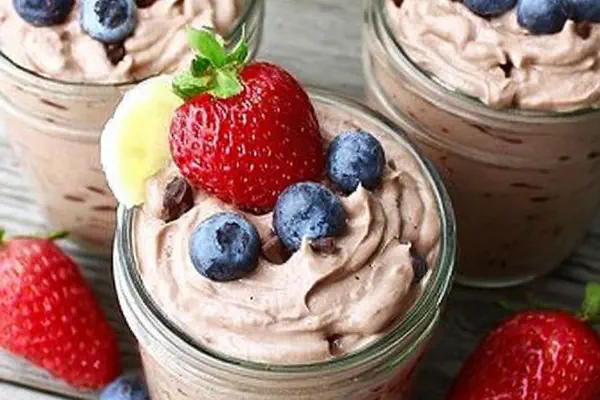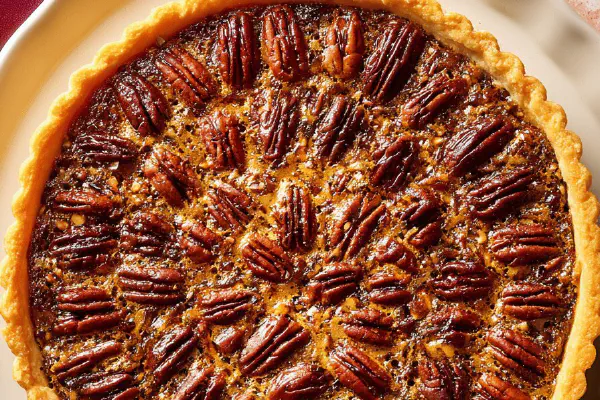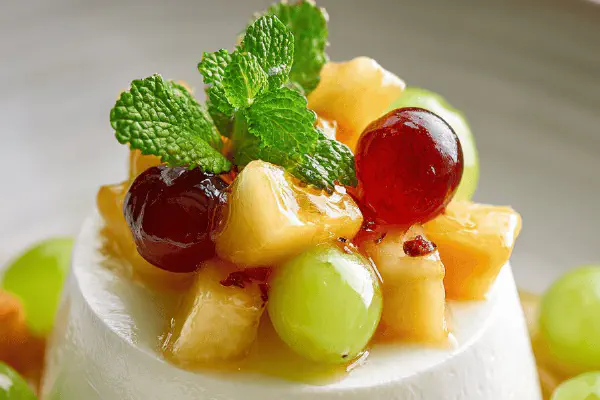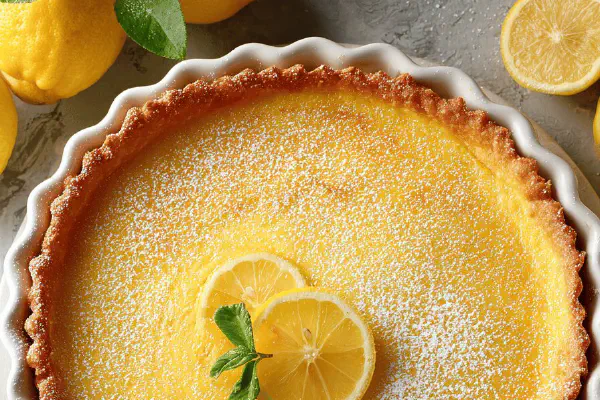Featured Recipe
Pistachio Raspberry Mousse Tart

By Kate
"
A pistachio crumb crust anchors a vibrant raspberry mousse tart. Shelled pistachios combined with almond flour and browned butter add depth. Fresh mango slices replace some raspberries for a subtle tropical twist. Gelatin sets the airy mousse, made with whipped cream and fresh citrus. The tart chills until firm with a final layer of tangy raspberry-mango coulis. No eggs needed. The short bake time to toast crust and precise folding keep textures distinct. Refrigeration critical to clean slicing and flavor melding. Store chilled up to 3 days.
"
Prep:
25 min
Cook:
15 min
Total:
55 min
Serves:
8 servings
dessert
tart
mousse
Introduction
Feel pistachios toasted warm, smell the nuttiness as crust cooks — different from plain butter crust. Pressing almond flour with pistachios adds fat and bite; makes topping sturdy enough to hold moisture from filling. Why mango? Adds textural contrast and subtle sweetness, cuts raspberries tartness. Blooming gelatin is crucial — if rushed or overheated, you lose set. The purée’s temperature matters when folding with cream — too cold gelatin gel traps lumps, too warm melts whipped cream and collapses mousse. Patience—watch surfaces, textures, aromas. Chilling phases not arbitrary; each signals molecular changes. Fresh raspberries scatter unevenly? They compress and shrink; don’t overfill. Folding whipped cream too aggressively deflates air; firm mousse turns dry. The last coulis layer adds brightness, color, balances sweetness. A sharp serrated knife cleans edges, preserves layers. The tart’s texture and flavour develop over hours in fridge. No eggs—stable mousse solely from gelatin and cream, easier but precise. This method works even if fresh berries short. Replace with thawed frozen for no compromise. One slip and mousse splits or curdles — watch temps. Chill, slice, serve. Less fuss than it looks.
Ingredients
Pistachio crust
- 60 g shelled unsalted pistachios
- 35 g superfine sugar
- 100 g almond flour
- 55 g browned butter, cooled
- 100 g fresh raspberries
- 8 ml gelatin powder
- 45 ml cold water
- 180 g fresh or thawed frozen raspberries
- 60 g diced ripe mango
- 70 g granulated sugar
- 25 ml fresh lemon juice
- 150 ml 35 % whipping cream
- 80 g raspberries
- 20 g diced mango
- 15 g granulated sugar
Mousse
Topping coulis
About the ingredients
Pistachios unsalted, shelled, ideally fresh for best aroma. In a pinch, use blanched almonds for crust but flavor is milder. Browned butter increases nuttiness and richness; if pressed for time, clarified butter or melted unsalted butter works but flavor flattens. Almond flour lends fat and moisture; can substitute with finely ground oats for gluten-intolerance but texture shifts. Fresh raspberries preferred but frozen and thawed are OK; drain excess liquid to avoid soggy crust. Gelatin powder bloom essential; powdered works smoother than sheets but sheets can be substituted by adjusting quantity (1 sheet ≈ 1.5 tsp powdered). Mango diced adds mild sweetness and freshness; other stone fruits like peach or nectarine can substitute seasonally. Use real whipping cream, not stabilized or reduced fat; whipping ability impacts mousse volume and stability. Sugar amount balances acidity — adjust to raspberries’ tartness and mango ripeness. Lemon juice brightens but do not exceed amount or mousse may seize.
Method
Pistachio crust
- Position rack mid-oven; preheat 175 °C (347 °F).
- Pulse pistachios with sugar in food processor until coarse meal forms — no oily paste. Add almond flour, pulse briefly.
- Add browned butter; pulse just to combine. Should clump when pinched. Too wet — adds more almond flour sparingly.
- Press firmly into 23 cm (9 inch) removable bottom tart pan, up sides evenly. Pat firmly to avoid cracks after baking.
- Bake about 15 minutes until edges golden-brown and nutty aroma rises. Cool at least 35 minutes. Crust firms as it cools.
- Spread fresh raspberries gently in crust without crushing; watch for overflow beyond pan’s rim — raspberries compress during chilling.
- Sprinkle gelatin over cold water in small bowl; bloom 7-8 minutes until surface looks spongy but intact.
- Meanwhile, blend 180 g raspberries, mango, sugar, lemon juice until smooth. Pass through fine mesh sieve over small saucepan; discard seeds.
- Heat purée over medium until just shy of boil — small bubbles appear around edges. Remove from heat immediately.
- Stir in gelatin fully until dissolved, no granules. Remove 150 ml (about 2/3 cup) purée into mixing bowl; set rest aside, leave warm.
- Let gelatine mixture cool at room temp for 15 minutes — softly thickened, not set. Too cold and gelatin locks up; too warm and cream will melt.
- Whip cream to soft peaks, still pliable. Fold one-third cream into purée gently to lighten. Fold remaining cream carefully — preserve air bubbles for mousse texture.
- Spread mousse evenly over raspberries in tart shell; smooth top with angled spatula. Chill 35 minutes until surface feels set but not firm.
- Wash spatula now or crust picks up stray spices when used for topping.
- Combine remaining 80 g raspberries, mango, sugar in small saucepan. Cook gently until sugar dissolves, fruit softens but not broken down, about 5 minutes. Cool slightly.
- Spread coulis over mousse evenly with spatula. Return tart to fridge for 3.5 to 4 hours or until mousse is firm and holds shape when touched.
- To unmold, run small offset spatula between pan and tart edge to loosen gently; invert base if removable. Use sharp serrated knife to cut neat slices; wipe blade between cuts to prevent smearing.
- Store tart covered in refrigerator for up to 3 days. Let sit 10 minutes at room temp before serving to mellow chilled firmness.
Mousse preparation
Final coulis layer
Technique Tips
Baking crust until golden nutty smell appears, edges firm to touch; visual and smell cues over timer. The crust must cool fully — still warm and the butter bleeds into pan and weakens structure. Distribute berries so surface not overly crowded — they shrink during chilling; gaps will fill with mousse, maintaining even thickness. Bloom gelatin fully — unmixed powder signals poor set, lumps. Heat purée carefully; boiling destroys flavor, curdles gelatin. Cool purée to just thickened texture before cream; if foam collapses, mousse has runny texture. Whip cream to soft peaks; over-whipped cream stiffens and is hard to fold, under-whipped mousse lacks volume and firmness. Fold cream gently—use spatula slicing motion, avoid stirring. Chill mousse until surface feels gelatinous but flexible; testing by light touch with finger. Wash spatula before coulis layer to prevent crust disruption. Final coulis cooks fruit gently — broken fruit and sugars meld, giving gloss and tangy topping. Refrigerate fully until mousse firm to slice cleanly; premature slicing leads to mess. Loosen tart carefully before removing sides to prevent breakage. Sharp knives and gentle wiping between cuts make neat slices, showcasing really crisp crust and airy mousse contrast.
Chef's Notes
- 💡 Waiting for crust to cool completely is critical. If warm, the crust can weaken; watch for golden edges and nutty aroma. Those signals mean it's done. Filling warm crust can lead to soggy bottom. Not a good look.
- 💡 When preparing gelatin, bloom it slowly. Sprinkle over cold water; avoid heating it too quickly. If it clumps, set up a disaster for mousse. Keep attention on texture. Too thick? Start again, or add liquid slowly to rescue it.
- 💡 When whipping cream, soft peaks are key. Too stiff, won’t fold well. Too soft, mousse collapses. Whip gently and check often. Cream should hold its shape; visual cue is crucial. Think velvety, airy. That's the goal.
- 💡 Raspberries can collapse during chilling. Don’t overpack the crust — gaps make a big difference. Watch that space; mousse fills in. Using frozen raspberries is fine, but drain excess liquid well.
- 💡 Final coulis? Don't rush. Cook gently, melting sugar into fruits. If broken down too much, too liquid. Look for slight thickness; it adds gloss. Chill after, aligns flavors. Fruit should still have some form.
Kitchen Wisdom
Can I use different nuts for crust?
Yes you can. Try almonds, walnuts. Less flavor depth. Consider texture differences too; adjust flour amounts based on nut oils.
What if my mousse doesn’t set properly?
First check gelatin bloom status. Was it too warm or too cold? If not thick, whisk in more whipped cream slowly, re-approach tempering.
Can frozen fruits replace fresh?
Definitely possible. Thaw and drain them. Too much liquid ruins texture. Just remember, frozen fruits could impact overall sweetness too.
How to store leftovers?
Keep in an airtight container. Refrigerate, up to three days. Tart can lose some texture, but flavors meld. Serve at room temp for softer texture.



